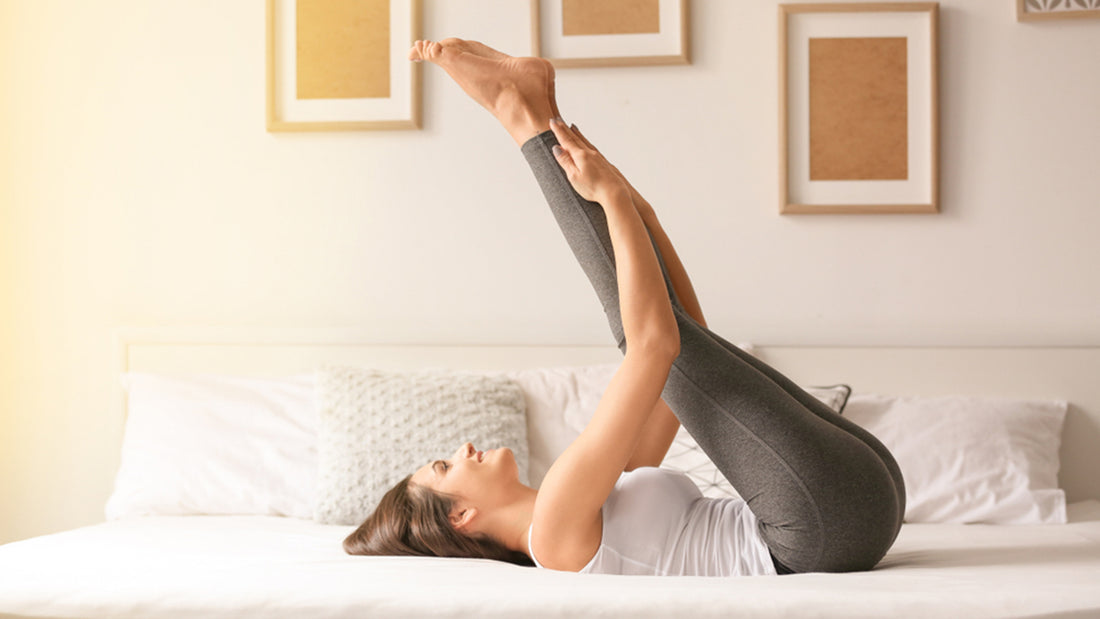
If you’ve read our blog for long, you know how important it is to develop a relaxing bedtime routine in order to fall asleep quickly and sleep deeply throughout the night. Your body isn’t a machine you can simply flip a switch to turn off when you’re ready to go to sleep. Your mind and body need time to settle down. There’s quite a few activities we recommend you experiment with putting into your calming nightly routine, including listening to soothing music and reading a book before bed.
Developing a routine helps your brain separate the day from the night, clears your thoughts of the day's stresses, and eases your body into a deep slumber. While it may seem like being still and calm are essentially the same thing, there are physical activities that help you relax for sleep instead of waking you up and making you sweat. This includes a healthy yoga routine, as well as tai chi and simple stretching.
Restorative Yoga Poses
Restorative yoga uses floor-based poses that you might have done in a daytime ‘vinyasa’ class, and makes slight variations to make them suitable for the late evening. The biggest difference is that you stay in each pose for a longer period of time, encouraging you to let your body relax, aided by the support of bolsters, blankets, and pillows. That’s right- you can do these poses in bed! A few of our favorite restorative yoga poses include:
#1 Waterfall: Lie on your back, lifting and extending your hips and sit bones a little to make sure that your back is nice and long. Bring your knees up to your chest and extend your legs so that they’re at a 90-degree angle to your body. Bring your arms out to the side, close down the eyes and relax, breathing deeply for 10 up to 15 breaths. You can also do this pose against the wall or your headboard for a more restorative version.
#2 Happy Baby: From Waterfall, bring your knees back into your chest and grab the outside of the sides of your feet. Extend your legs a little and bring your knees wide, letting your elbows fall inside your thighs. As you push into your hands, you should feel a nice stretch. If you want to, you can gently roll from side to side or forward and backward to give your lower back a gentle massage.
#3 Sleeping Butterfly: Your hips can become closed and tight from sitting all day. Slowly bring yourself up from Happy Baby and bring the soles of your feet together in front of you. Your feet can be as near or as far away from your pelvis as you like. Inhale and stretch your spine upwards, then gently start to fold forwards, making sure to curve your spine and neck to bring your forehead towards your feet.
Tai Chi for Sleep
Tai chi originated as martial arts in China hundreds of years ago, and it has been used for physical and mental health ever since. Practicing tai chi allows you to become increasingly aware of the energy flowing around your body, which can help you calm down from a busy day.
There are several types of tai chi, and most types involve using a combination of concentration, meditation, weight shifting, and slow movements. Tai chi calms your nervous system and helps you be “in the present,” as it requires focusing on the sensations your body feels as you breathe. Performing tai chi has been shown to help improve sleep quality, reduce stress, and help you relax. In fact, a 2018 study in Frontiers in Psychiatry concluded that slow, deep breathing techniques can be more effective at combating insomnia than modern sleep medications.
To do tai chi for sleep, perform some simple shoulder rolls and loosen your joints by turning your head side to side. Focus on your breath as you practice deep breathing. Stand with your feet pointing forward. Move your body towards one side for as far as you can bend, bring it back to the center position, and repeat on the other side. The “Horse Stance” is another good exercise before bed. Stand with your feet wide apart, keeping your spine and neck straight. Bend from your knees to 90 degrees and lift your arms until they are aligned straight in front of your chest.
The Benefits of Stretching Before Bed
A 2012 study from the National Center for Complementary and Integrative Health collected survey data from almost 35,000 adults and found that over 55% of participants who practiced yoga reported better sleep. Similarly, a 2018 study in Sleep found that stretching before bed reduced the severity of insomnia and improved the sleep of those with chronic insomnia. By stretching before bedtime, you can reduce the likelihood of leg cramps, back pain, and other joint aches at night.
There are millions of Americans who don’t get enough sleep on a regular basis, according to the CDC. If you’re one of them, we encourage you to take steps in order to fix the problem. If you have trouble falling and staying asleep, it may be because you’re not relaxing properly. Beyond sleeping on a high-quality premium mattress, creating a bedtime routine that involves yoga, tai chi, and stretching is one of the easiest steps you can take to enjoy better sleep. A simple lifestyle change can help your body, mind, and soul relax before bed. If you’re looking for a new way to improve your nightly routine, give one of these activities a try! A proper bedtime routine that involves yoga or other forms of stretching your body has numerous benefits to the night of sleep ahead.

